One of over two hundred varieties of Asclepias, ‘Silky Mix’ stands out for its beautiful alternating deep red and gold colored blooms. Blooming mid Summer through early Fall, ‘Silky’, like most Asclepias prefers sunny, dry locations and does well in substandard soil. A tender perennial in some zones and annual in others, ‘Silky Mix’ is a beautiful addition to any garden or patio and will attract many different types of butterflies and other pollinators. Also known as “butterfly weed” because of its propensity for hosting the colorful insects, ‘Silky Mix’ makes a beautiful border or walkway plant but will also do well in a deep pot or container.
We got this plant from the Annie’s Annual section of Yamagami Nursery in Cupertino CA.
Known to have some medicinal value as a cough expectorant, the plant’s milky white sap can also cause irritation if it comes into contact with your eyes. Asclepias contain cardiac glycosides that are poisonous to humans, but they pose the most danger to grazing animals.
Asclepias need cold weather to prepare the plant for high yields of flowers, so first year plants may not perform well or bloom as vigorously without exposure to the cold.
Features
Zones: 7 – 10
Size: 36″H x 18″S
Light: Full sun
Bloom: Red, Yellow, Orange, blooms in Summer – Fall
Uses: ‘Silky Mix’ is a gorgeous addition to your garden and will attract droves of butterflies. The plant also has some medicinal value as a cough expectorant. Grows well in rock gardens because it is drought tolerant.
Tips: Start your plants in August for earlier blooming in the next season.
Bloom Characteristics:
This plant is attractive to bees, butterflies and/or birds
Water Requirements:
Average Water Needs; Water regularly; do not overwater
Where to Grow:
Unknown – Tell us
Height:
18-24 in. (45-60 cm)
24-36 in. (60-90 cm)
36-48 in. (90-120 cm)
Spacing:
18-24 in. (45-60 cm)
Hardiness:
USDA Zone 8a: to -12.2 °C (10 °F)
USDA Zone 8b: to -9.4 °C (15 °F)
USDA Zone 9a: to -6.6 °C (20 °F)
USDA Zone 9b: to -3.8 °C (25 °F)
USDA Zone 10a: to -1.1 °C (30 °F)
USDA Zone 10b: to 1.7 °C (35 °F)
USDA Zone 11: above 4.5 °C (40 °F)
Sun Exposure:
Full Sun
Danger:
Parts of plant are poisonous if ingested
Bloom Color:
Red-Orange
Bloom Time:
Mid Summer
Late Summer/Early Fall
Foliage:
Herbaceous
Other details:
Unknown – Tell us
Soil pH requirements:
6.1 to 6.5 (mildly acidic)
6.6 to 7.5 (neutral)
Patent Information:
Unknown – Tell us
Propagation Methods:
By dividing rhizomes, tubers, corms or bulbs (including offsets)
From seed; direct sow outdoors in fall
From seed; winter sow in vented containers, coldframe or unheated greenhouse
From seed; stratify if sowing indoors
Seed Collecting:
Bag seedheads to capture ripening seed
Allow pods to dry on plant; break open to collect seeds
Properly cleaned, seed can be successfully stored
Read more: http://davesgarden.com/guides/pf/go/81057/#ixzz3lf0VeiCh








